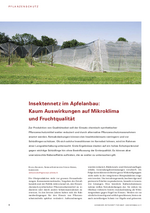Insektennetz im Apfelanbau, Schweizerische Zeitschrift für Obst- und Weinbau
Chemical synthetic pesticides are needed to produce high quality fruits. However, the use of pesticides is put more and more into question in Switzerland. Therefore, there is a need for alternative measures to protect orchards from pest insects and fungal diseases. One possible solution to reduce the amount of applied insecticides are side nets to exclude pest insects. To investigate the influence of these nets on pest insects and the microclimate, Agroscope started in 2012 a long-term research project with the varieties Opal and Milwa-Diwa. Out of 16, eight tree rows are only covered with a hail net, whereas the other half is additionally enclosed with a fine-meshed side net from full bloom until harvest. Since 2016, the effects of the side net on pest and beneficial insects, fruit growth, the photosynthetic activity, the amount of fruits harvested, the fruit quality and the microclimate are measured.First results indicate that side nets successfully protect apple orchards from pest insects without influencing temperature or fruit quality at harvest. However, undesirable side effects may occur as a consequence of increased humidity and reduced wind speed in plots with side nets. If leafs and fruits remain wet for a longer time, fungal infections may increase. This would require additional applications of fungicides compared to plots without side nets. In 2017, therefore, we will also measure if fungal infections are increased in plots with side nets.
Documents

|
Insektennetz im Apfelanbau, Schweizerische Zeitschrift für Obst- und Weinbau () |
Details
- Activity type
- Publication in technical journal
- Activity work package
- Secure sustainable fruit production
- Activity number
- Agroscope-WP5-A23
- Activity contact
- Dr. Thomas Kuster
Agroscope
Schloss 1
Postfach
8820 Wädenswil
Schweiz
Tel. +41 58 460 62 43
[email protected]
- Activity partner
- AGROSCOPE
- Activity country
- Switzerland
- Last edit
- 18-10-2017

The EUFRUIT thematic network has received funding from the
European Union's Horizon 2020 research and innovation programme
under grant agreement No 696337.
European Union's Horizon 2020 research and innovation programme
under grant agreement No 696337.